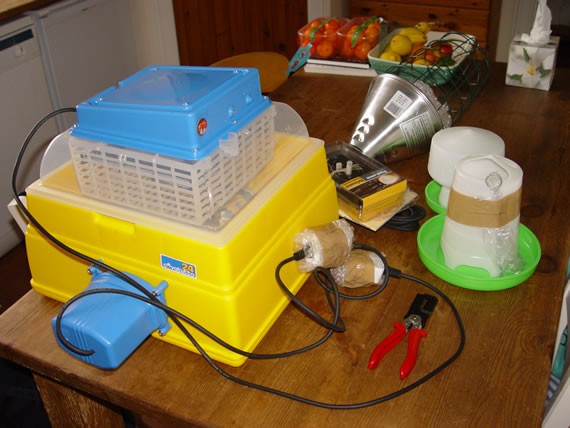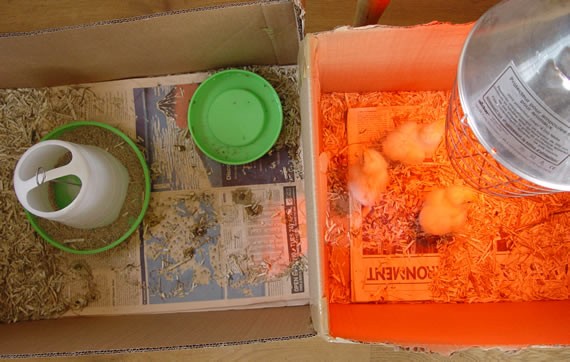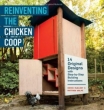Hatching eggs and rearing chicks
Incubators
To hatch eggs you’ll need either an incubator or a broody hen. As hens can’t be relied on to go broody at the right time, most poultry breeders will invest in an incubator.
There is any number of types of incubator available. Incubating eggs should be turned at least five times a day (the broody hen will do this herself) so I’d recommend getting one with an automatic turning mechanism.
 We started with a complete home hatchery, although the Covatutto incubator sucked
We started with a complete home hatchery, although the Covatutto incubator sucked
Eggs for incubating should be kept for no more than a week before setting, otherwise hatch rate will diminish. Choose eggs that are clean, medium sized and free from blemishes or odd shapes.
Aim to keep the incubator somewhere where it will be free from wide temperature fluctuations. A spare bedroom is fine. The instructions for the incubator are pretty straightforward but in the UK, there is normally no need to put water in the incubator, as the humidity of the atmosphere is adequate.
Incubation period for chickens
The incubation period for hen eggs is 21 days; on day 19, stop turning the eggs. When the eggs start to hatch, the temptation is to get involved and help. In my limited experience, I've both left well alone and helped and either would have been both the right and the wrong thing to do, in different circumstances. So no help there, then.
Hatching, brooders and heat lamps
Once the chicks hatched, you can leave them in the incubator for 24 hours to dry off then transfer them to a brooder and / or heat lamp. You can buy brooders or build your own. Remember, new chicks are very small and can wander away from the heat lamp, so make sure your brooder will keep them secure.
The chicks will let you know if they are unhappy – noisy chicks are generally unhappy chicks. If they are huddled together, they are too cold; if they are panting and spread around the box, they are too hot – so raise the heat lamp until they look comfortable.
Our first brooder was a small cardboard box inside a larger wooden box with a "door" cut between the two, with the lamp over the small box and an unheated part with food and water. The chicks soon get the idea of going back and forward. The boxes are lined with newspaper and hemp.
Once they get a bit bigger, the small box is removed. Once they get a bit bigger still, maybe seven to ten days old, they are allowed out into the attached run, which has a rubber floor (horse matting) and hemp bedding. The box is cheap and can be replaced for each new hatch.
The floor of your brooder should have a non-slip floor or the chicks can develop splayed legs. A clean hessian sack is good and can be burnt once it’s dirty.
 Our original "cardboard city" brooder
Our original "cardboard city" brooder
If any chicks do get splayed legs, it can be corrected by tying the legs together, leaving enough slack for the chick to walk. In time, the muscles will strengthen and the legs will return to normal.
Chick crumbs
You will need a specialist chick crumb that is small enough for the chicks to eat and high in protein and other nutrients. Some contain an antibiotic called a coccidiostat, which is a drug to control coccidiosis. There are antibiotic free feeds available and if you only raise a few chicks non-intensively and have no disease problems, you may wish to avoid the routine feeding of antibiotics, the practice of which has been linked to the development of antibiotic resistance.
To encourage the chicks to feed, sprinkle crumbs on the base of the box - the movement seems to attract the chicks' attention and encouraged them to peck. You can also mimic the action of pecking with your finger to encourage the chicks to copy.
Coccidiosis
Coccidiosis can be a serious problem for young chicks and can cause high mortality rates. Infected chicks will be listless, have white diarrhoea and possibly blood in the faeces. The main causes are damp and overcrowded conditions so keeping the chicks clean, dry and in plenty space is important for their health and welfare.
You can vaccinate against coccidiosis using Paracox, which protects the bird for life. It is available from The Poultry Club of Great Britain.
Water for chicks
Water should be available from day one. Use a jam jar lid or fill a saucer with a layer of small stones so that the chicks can’t fall in and get chilled – they aren’t awfully steady on their legs for the first 48 hours or so. Small chick drinkers are commercially available, too.
You may need to dip the chicks’ beaks in the water to give them the idea. Do so gently and they will soon catch on.
Bringing your chicks on
Once they get to about a week old, give them some toys. A box to hop on and off, some branches as perches, hang up a CD, hang up some greens for them to peck at.
Keep them on chick crumbs until six to eight weeks old, then you can start to introduce grower / finisher pellets, some corn and grit. Don’t put them on to layer pellets until they come into lay at 22-24 weeks because the calcium supplement can cause kidney failure.
Once they have moulted their chick down and have feathers, they can come off the heat lamp and can go outside if the weather is good. It’s impossible to say categorically when this is since it is influenced by so many factors – just keep an eye on the chicks’ behaviour and you’ll be able to judge if they are too cold.
Remember, there is any number of animals that will prey on small chicks – rats, cats, hawks, stoats – and adult hens may be less than welcoming so the chicks must be kept in a covered enclosure until they are at least eight weeks old and preferably until they start to lay.
If you hatch chicks in an incubator, it’s easy to get too “broody” yourself. Watching chicks being raised by a hen puts it all in perspective, as Mother Nature takes care of things! If you have a hen go broody and you are happy to sacrifice eleven weeks egg production, then set a few fertilised eggs under her. She will need a quiet, dark nesting box, away from the other hens. Put the eggs under her at night, when she’s nice and calm.
You may have to force her to get off the nest, morning and evening, to eat, drink and defecate – she’ll do these things in a rush and get straight back on her eggs. She’ll turn the eggs and keep them at the right temperature and humidity; she’ll teach the chicks how to find food and water, to scratch and peck and dust bathe – all you have to do is watch and enjoy!
- Previous « Breeding Poultry
- Next Poultry for meat »

About Rosemary Champion
Rosemary lives on a 12 acre smallholding in Angus, in the east of Scotland, where she keeps Ryeland Sheep, Shetland cattle and assorted poultry. She was destined to be a smallholder from an early age.
Further Reading
 Chicken & Eggs: River Cottage Handbook No.11 Mark Diacono |  Storey's Guide to Raising Chickens Gail Damerow |  A Beginners Guide to Caring for Ex-Batts Jo Barlow |  Reinventing the Chicken Coop Matthew Wolpe |  Chickens: The Essential Guide to Choosing and Keeping Happy, Healthy Hens Suzie Baldwin |
Smallholding shop
When you click links below and make a purchase, this may result in this site earning a commission from eBay.

Mushroom Poultry Drinker 1.3li
Mushroom Poultry Drinker.… from £3.02 + p&p

vital Vits - 250ml
High concentrate of… from £5.58 + p&p

Stockholm Tar 450g
A useful addition to the… from £6.06 + p&p

Viratec - P Disinfectant 500g
… from £11.89 + p&p
















